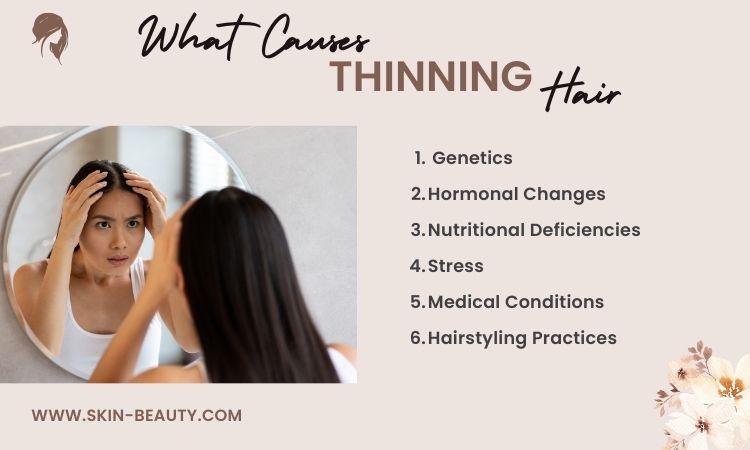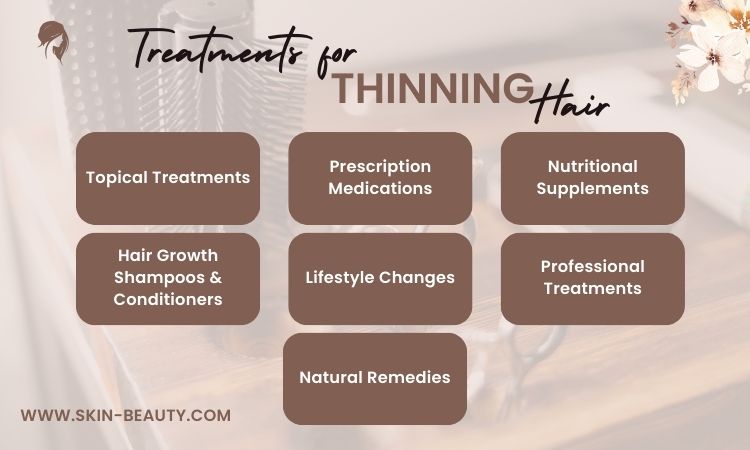Hair Loss Treatment For Thinning Hair
Thinning Hair Loss and Treatment: Understanding Causes and Solutions
Thinning hair and hair loss can be distressing experiences for many individuals, leading to a quest for effective treatment options. Understanding the underlying causes of hair loss is crucial for determining the best course of action. This article delves into the various factors contributing to thinning hair, explores effective treatment options, and provides insight into how to manage and prevent further hair loss.
What Are the Common Causes of Hair Loss and Thinning Hair?
Understanding Different Types of Hair Loss
Various types of hair loss exist, each with unique characteristics and causes. One prevalent type is androgenetic alopecia, commonly known as male or female pattern baldness. This hereditary condition affects both men and women, leading to gradual thinning of hair over time. Another type is alopecia areata, characterized by patchy hair loss that can occur suddenly. Recognizing the type of hair loss you are experiencing is essential, as it influences the treatment options available. Other factors, such as stress, hormonal changes, and environmental influences, can also contribute to hair loss, making it vital to understand the specific cause of your hair thinning.
How Medical Conditions Contribute to Hair Thinning
Medical conditions can significantly impact the health of your hair. Conditions such as thyroid disorders, iron deficiency anemia, and autoimmune diseases are known to cause hair loss. For instance, thyroid imbalances can disrupt the hair growth cycle, leading to thinning hair and hair fall. Additionally, chronic illnesses or treatments such as chemotherapy can precipitate temporary hair loss. Understanding these medical conditions is crucial for addressing the underlying issues and facilitating effective hair loss treatment. Consulting with a healthcare professional may help identify any medical condition that could be causing your hair loss.
The Role of Genetics in Female Pattern Hair Loss
Genetics plays a pivotal role in female pattern hair loss, which can manifest as a gradual thinning of hair across the scalp. This hereditary hair loss often begins in women during their late teens to early twenties and can be exacerbated by hormonal changes, particularly during menopause. Understanding the genetic factors influencing your hair loss can empower you to seek appropriate treatment options. If you have a family history of hair loss, it’s essential to be proactive in managing your hair health and exploring possible treatments to combat thinning.

What Are Effective Hair Loss Treatments Available Today?
Exploring Minoxidil as a Treatment for Thinning Hair
Minoxidil, a widely recognized treatment for hair loss, is available over-the-counter in both liquid and foam forms. This topical solution works by stimulating hair follicles, promoting new hair growth, and slowing the progression of hair loss. It is particularly effective for individuals experiencing androgenetic alopecia. Regular application of minoxidil may help restore hair density and improve the overall appearance of thinning hair. However, it's important to note that results may vary, and consistent use is necessary to maintain any achieved hair regrowth.
Hair Transplant Options: What You Need to Know
Hair transplant procedures may be an effective option for those seeking more permanent solutions to hair loss. These surgical techniques involve transferring hair follicles from donor sites on the scalp to areas experiencing thinning or baldness. Follicular unit extraction (FUE) and follicular unit transplantation (FUT) are two popular methods. While hair transplants can provide natural-looking results, they require a thorough consultation with a dermatologist to determine suitability and expected outcomes. Having realistic expectations and understanding that this treatment option may require a financial investment is essential.
Home Remedies and Lifestyle Changes to Stop Hair Loss
In addition to medical treatments, various home remedies and lifestyle changes can help slow hair loss and promote healthy hair growth. Consuming a balanced diet rich in vitamins and minerals, particularly those known to support hair health like biotin, zinc, and iron, can make a significant difference. Additionally, practicing good hair care routines—such as avoiding harsh chemicals and heat styling tools—can help prevent further damage to your hair. Incorporating stress-reduction techniques, such as meditation and exercise, can also be beneficial, as stress is a common factor causing hair loss.

How Can You Diagnose Your Hair Thinning Issues?
Consulting a Dermatologist for Hair Loss Diagnosis
When experiencing hair thinning, consulting a dermatologist is a crucial step towards an accurate diagnosis and effective treatment. A dermatologist specializes in hair and scalp conditions and can conduct a thorough examination to identify the cause of your hair loss. They may inquire about your medical history, lifestyle, and family history of hair loss to gain a comprehensive understanding of your situation. This consultation can lead to tailored treatment options based on the specific type of hair loss affecting you.
Tests and Assessments for Identifying the Cause of Hair Loss
To diagnose the cause of your hair loss accurately, dermatologists may recommend various tests and assessments. These can include blood tests to evaluate hormone levels, iron deficiency, or thyroid function, as well as scalp biopsies to examine hair follicles. These diagnostic tools are essential for determining the underlying issues causing your hair thinning. Once the cause is identified, appropriate treatment options can be discussed, increasing the likelihood of successful hair regrowth.
Recognizing Signs of Alopecia Areata and Other Conditions
Recognizing the signs of alopecia areata is vital for early intervention. This autoimmune condition often presents as small, round patches of hair loss, and can sometimes lead to total body hair loss. Understanding the symptoms of alopecia and differentiating it from other types of hair loss is essential for seeking timely treatment. If you notice any sudden changes in your hair, such as patchiness or excessive shedding, consulting with a healthcare professional can help you address the issue effectively.
What Are the Best Practices to Regrow Hair and Stop Thinning?
Nutritional Tips for Healthy Hair Growth
Nutrition plays a crucial role in promoting healthy hair growth and preventing thinning. Incorporating foods rich in omega-3 fatty acids, such as salmon and walnuts, can support scalp health. Additionally, foods high in antioxidants, like berries and leafy greens, can protect hair follicles from damage. Ensuring adequate protein intake is also essential, as hair is primarily made of protein. A well-rounded diet tailored to support hair health can facilitate new hair growth and enhance the strength of existing hair.
Medications That May Help Regrow Hair
In addition to minoxidil, several other medications may help regrow hair and treat hair loss. Finasteride, a prescription medication primarily used for male pattern baldness, works by blocking the hormone responsible for hair loss. Women may also benefit from hormonal treatments if their hair thinning is linked to hormonal changes. It’s essential to consult with a healthcare provider to explore these options and determine the most suitable medication for your specific situation.
Natural Treatments for Thinning Hair to Consider
Natural treatments for thinning hair can complement medical therapies and promote overall hair health. Essential oils, such as rosemary and peppermint oil, are known for their stimulating properties and may help enhance blood circulation to the scalp. Scalp massages can also be beneficial in promoting hair growth by improving blood flow to hair follicles. Herbal supplements like Viviscal Professional Hair Growth and saw palmetto are believed to support hair health and may help reduce hair loss. Additionally, many products on the market such as Bosley Shampoo or Capilus Laser Cap are designed to promote hair growth. Always consult a healthcare professional before starting any new treatment to ensure it aligns with your individual health needs.
How to Manage Female Pattern Hair Loss Effectively?
Understanding the Impact of Hormones on Female Hair Thinning
Hormones significantly influence female pattern hair loss, particularly during life stages such as puberty, pregnancy, and menopause. Fluctuations in hormone levels can affect the hair growth cycle, leading to thinning and hair loss. Understanding how hormonal changes impact your hair can empower you to seek appropriate treatment options. Hormonal therapies may be available to help mitigate the effects of hormonal imbalances on hair health, making it essential to communicate with a healthcare provider about any concerns related to hair thinning.
Strategies for Coping with Female Pattern Baldness
Coping with female pattern baldness requires a multifaceted approach. Emotional support from friends and family can be invaluable during this challenging time. Additionally, exploring hairstyles that create the illusion of volume, such as layered cuts or volumizing products, can help boost confidence. Engaging with support groups or online communities can provide a sense of connection and understanding among those experiencing similar challenges. Addressing the psychological aspects of hair loss is just as important as finding effective treatment options.
Support Groups and Resources for Women Experiencing Hair Loss
Support groups and resources are vital for women navigating the emotional and physical aspects of hair loss. Organizations such as the American Hair Loss Association offer valuable information, support, and community for those experiencing hair loss. Engaging with these resources can provide not only emotional support but also insights into effective treatments and coping strategies. Remember, you are not alone in this journey, and there is a wealth of support available to help you manage and overcome hair loss.
Recent Posts
-
The Power of Exosomes in Skincare
Exosomes in Skin Care: The Future of Exosome and Regenerative Medicine in Skin Science Skincare inn …Oct 17th 2025 -
Steps for a Skincare Routine
6 Steps to a Proper Skin Care Routine: Your Esthetician-Approved Guide to The Best Skin If you've ev …Aug 11th 2025 -
Treatment of Hyperpigmentation
How to Treat the Appearance of Hyperpigmentation This Summer: Your Complete Guide Summer sun is wond …Jul 17th 2025




